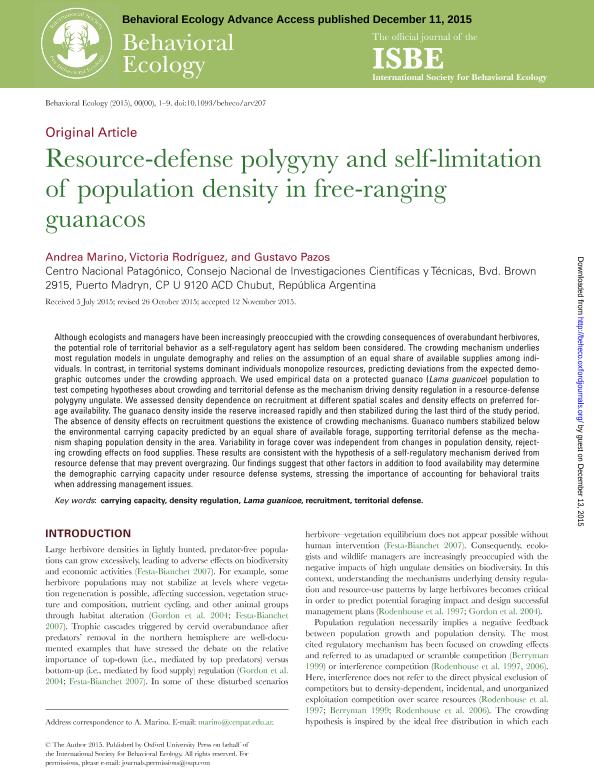Mostrar el registro sencillo del ítem
dc.contributor.author
Marino, Andrea Ivana

dc.contributor.author
Rodriguez, Maria Victoria

dc.contributor.author
Pazos, Gustavo Enrique

dc.date.available
2018-05-10T14:37:23Z
dc.date.issued
2016-01
dc.identifier.citation
Marino, Andrea Ivana; Rodriguez, Maria Victoria; Pazos, Gustavo Enrique; Resource-defense polygyny and self-limitation of population density in free-ranging guanacos; Oxford Univ Press Inc; Behavioral Ecology; 27; 3; 1-2016; 757-765
dc.identifier.issn
1045-2249
dc.identifier.uri
http://hdl.handle.net/11336/44746
dc.description.abstract
Although ecologists and managers have been increasingly preoccupied with the crowding consequences of overabundant herbivores,the potential role of territorial behavior as a self-regulatory agent has seldom been considered. The crowding mechanism underlies most regulation models in ungulate demography and relies on the assumption of an equal share of available supplies among individuals. In contrast, in territorial systems dominant individuals monopolize resources, predicting deviations from the expected demographic outcomes under the crowding approach. We used empirical data on a protected guanaco (Lama guanicoe) population to test competing hypotheses about crowding and territorial defense as the mechanism driving density regulation in a resource-defense polygyny ungulate. We assessed density dependence on recruitment at different spatial scales and density effects on preferred forage availability. The guanaco density inside the reserve increased rapidly and then stabilized during the last third of the study period. The absence of density effects on recruitment questions the existence of crowding mechanisms. Guanaco numbers stabilized belowthe environmental carrying capacity predicted by an equal share of available forage, supporting territorial defense as the mechanism shaping population density in the area. Variability in forage cover was independent from changes in population density, rejecting crowding effects on food supplies. These results are consistent with the hypothesis of a self-regulatory mechanism derived fromresource defense that may prevent overgrazing. Our findings suggest that other factors in addition to food availability may determine the demographic carrying capacity under resource defense systems, stressing the importance of accounting for behavioral traits when addressing management issues.
dc.format
application/pdf
dc.language.iso
eng
dc.publisher
Oxford Univ Press Inc

dc.rights
info:eu-repo/semantics/openAccess
dc.rights.uri
https://creativecommons.org/licenses/by-nc-sa/2.5/ar/
dc.subject
Carrying Capacity
dc.subject
Density Regulation
dc.subject
Lama Guanicoe
dc.subject
Territorial Defense
dc.subject.classification
Otras Ciencias Biológicas

dc.subject.classification
Ciencias Biológicas

dc.subject.classification
CIENCIAS NATURALES Y EXACTAS

dc.title
Resource-defense polygyny and self-limitation of population density in free-ranging guanacos
dc.type
info:eu-repo/semantics/article
dc.type
info:ar-repo/semantics/artículo
dc.type
info:eu-repo/semantics/publishedVersion
dc.date.updated
2018-05-02T18:14:55Z
dc.identifier.eissn
1465-7279
dc.journal.volume
27
dc.journal.number
3
dc.journal.pagination
757-765
dc.journal.pais
Reino Unido

dc.journal.ciudad
Oxford
dc.description.fil
Fil: Marino, Andrea Ivana. Consejo Nacional de Investigaciones Científicas y Técnicas. Centro Nacional Patagónico; Argentina
dc.description.fil
Fil: Rodriguez, Maria Victoria. Consejo Nacional de Investigaciones Científicas y Técnicas. Centro Nacional Patagónico; Argentina
dc.description.fil
Fil: Pazos, Gustavo Enrique. Consejo Nacional de Investigaciones Científicas y Técnicas. Centro Nacional Patagónico; Argentina
dc.journal.title
Behavioral Ecology

dc.relation.alternativeid
info:eu-repo/semantics/altIdentifier/doi/https://dx.doi.org/10.1093/beheco/arv207
dc.relation.alternativeid
info:eu-repo/semantics/altIdentifier/url/https://academic.oup.com/beheco/article/27/3/757/2364814
Archivos asociados
